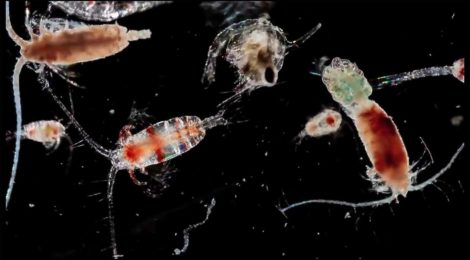
Lilliputian Heat Pumps, trillions of tiny fins, feet, and flippers – Part Two
Think humanity’s greenhouse gases are most important for global warming and climate change, think again.
Zooplankton, tiny animals that perform synchronous swimming in countless multitudes stir the ocean acting as living ‘solar-powered’ heat pumps. Their collective cooling power matches or even dwarfs the warming power of humanity’s greenhouse gases.
All is not well with Lilliputian ocean life, 70% have disappeared from much of the world’s oceans, and with their demise, the oceans are slowing and becoming still, sedentary and warmer at the surface and that’s not good.
Simple maths show restoration of global cooling ocean pastures is able to stop climate change in its tracks.
Think of ocean life, especially the tiny zooplankton swimmers (like the copepods seen in the photo above) when in healthy natural abundance number like the stars in the universe. They are Mother Nature’s air conditioners. She evolved her living Lilliputian heat pumps to have far greater efficiency than simple passive conductive cooling. To our never-ending horror, climate change global warming models treat the surface of the ocean as a simple cold surface not a cooling pump.
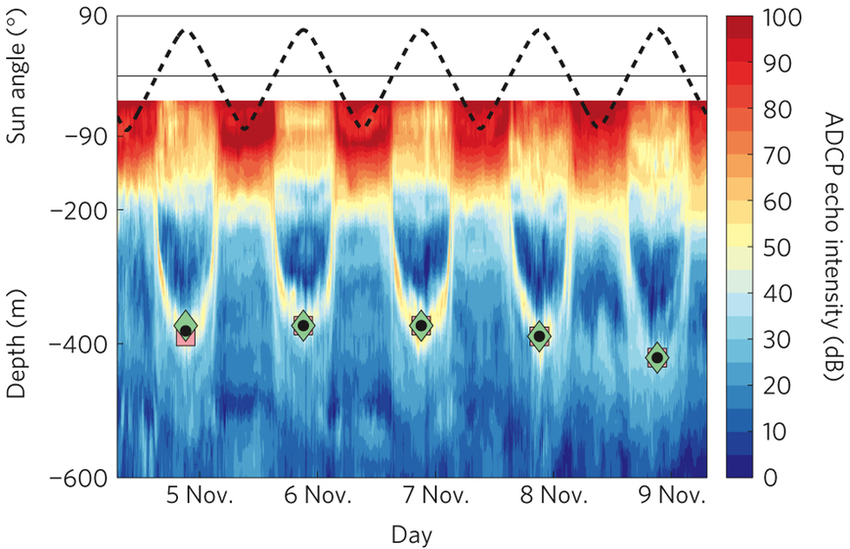
This sonar image (ADCP) shows the zooplankton night/day migration from the cold deep to the warm ocean surface. It is a massive living cooling pump imposing a vertical mixing cell with a 24 hr diel cycle that keeps their blue planet cool. Sadly in recent decades, we have turned the cooler to its lowest power setting as up to 70% of plankton have gone missing. At that setting global warming goes up unabated.
The living zooplankton fed on stored solar energy they eat at the surface every night are super-efficient, much like the technological heat pumps we use to heat and cool our homes. These ocean Lilliputians are most akin to ‘passive heat pump cooling technologies’ and as such deliver about 10 times the cooling power of the energy they use. Let’s not forget the energy they use comes from photosynthesis, so that is also energy that does translate into radiative global warming with respect to greenhouse gases.
Let’s examine the problem of global warming and our savior plankton cooling by the numbers.
From a comparative energy perspective, humanity uses about 16 terawatts of energy each year. That’s a lot, but ocean photosynthesis takes in about 64 terawatts or 4 times that amount.
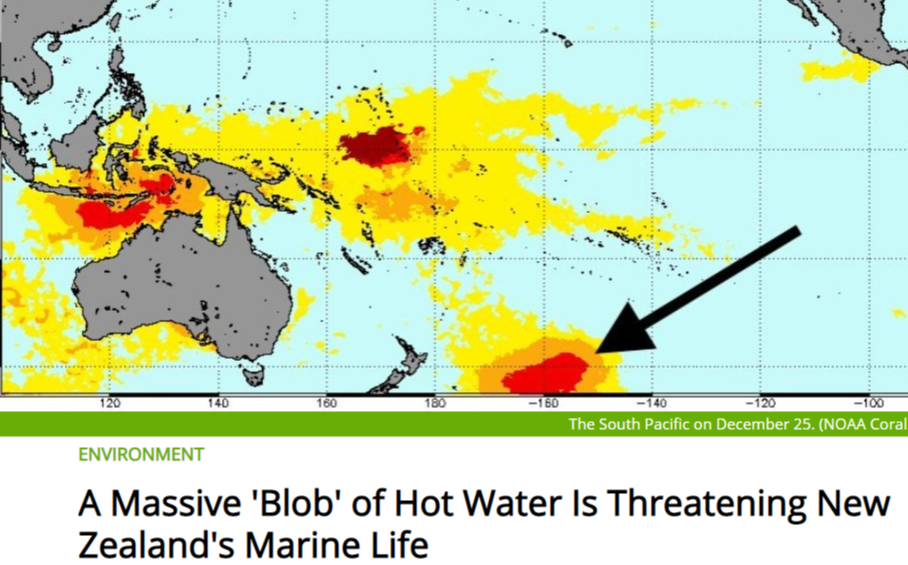
The South Pacific warm ocean anomaly just happens to be in the most extreme plankton desert on our blue planet. Is it any wonder that lost plankton cooling coincides with this massive region of 6 degree warmer water. Click to read more.
Next keep in mind that our Lilliputian friends, Mother Nature’s cooling force, have about a 10X efficiency factor in cooling provided per unit of energy expended. The 64 terawatts of plankton power thus multiplied by up to 10X get us to its cooling power, that’s a staggering 640 terawatts of cooling that keeps our blue planet in the Goldilocks Zone. Don’t forget to add in the 64 tw of solar power they use that doesn’t become part of the radiative heating burden on the planet so their real cooling capacity is ~700 terawatts.
Greenhouse Gases … meh, say the zooplanktors
The greenhouse gases that keep heat from escaping our planet, as our greenhouse gas blanket, are said to collectively keep about 800 terawatts of heat from escaping into space. There are some who would put that number lower, down around 500 terawatts, others higher. Additional confusion enters in when one tries to differentiate between natural greenhouse gases and anthropogenic ones, coming from human industry. The environmentally safe way to consider industry vs Nature numbers is to use the low numbers from engineers and the high numbers from Mother Nature.
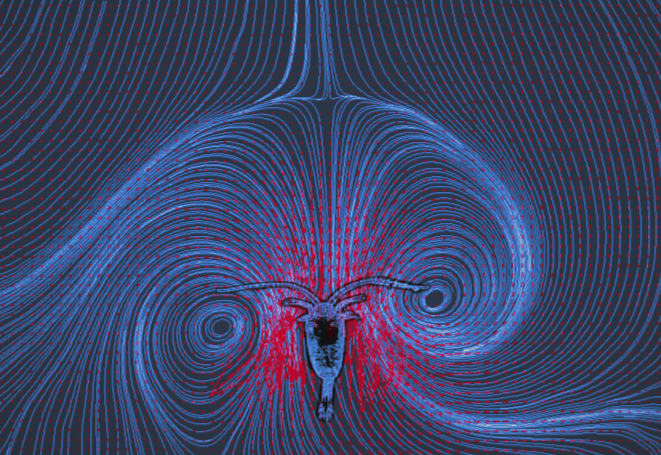
Tiny but mighty copepods produce hydrodynamic currents, these currents would not amount to much save for the fact that copepods tend to form synchronized swimming schools that swim up from the cold depths to the surface every evening and back down every morning numbering in the trillions of swimmers.
So the net problem of today’s global warming that can be accounted for by anthropogenic greenhouse gases amounts to an extra ~200-700 terawatts of heating that is warming this formerly comfortably cool blue planet of the plankton and humans.
But wait. The numbers above are troublesome.
We have 700 terawatts of extra anthropogenic global warming taking place but we also have ~700 terawatts (640+64) of natural global plankton cooling. How is it possible that we are observing ‘global warming’ with all that plankton cooling. The answer is simple and horrifying, something has gone wrong with our Lilliputian plankton friends.
Indeed, reports from around the world show a massive loss of plankton everywhere. Most recently in a major scientific paper the seas near Europe are reported to have lost 70% of their plankton. This cataclysmic loss of plankton and its cooling power is repeated everywhere.
Do the math, 70% of 700 terawatts, is just under 500 terawatts of cooling power lost. To say nothing of the collapse of fisheries as the plankton are the bottom of the fish food chain.
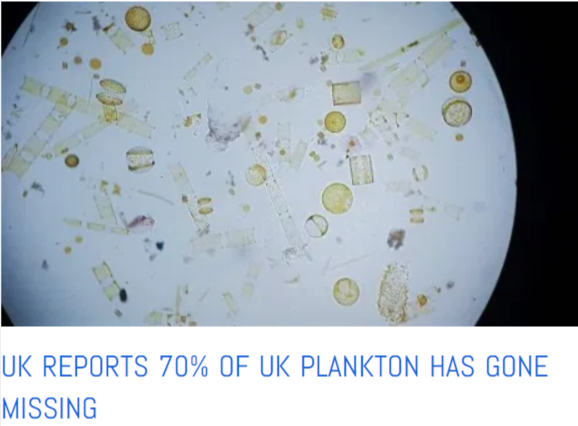
Published as part of a wide-ranging report by the Marine Climate Change Impacts Partnership (MCCIP), it shows 70% of UK plankton around the British Isles over the last 60 years has gone missing. Click to read more
To grasp the relative power of plankton synchronous swimming power consider this. It is widely reported that the total energy transferred into the ocean via winds and tides is about half a terawatt (0.6TW). But ocean life takes in 64 terawatts of energy through photosynthesis of the suns energy. Something like 80% of those 64 terawatts powers the consumers, the grazing copepods and kin, of phytoplankton and most of that energy goes into powering their trillions of tiny feet, fins, and flippers. The simple math shows that ocean life is a far larger mixing force that the winds and tides.
The human race in our present gluttony of energy madness consumes a bit less than 10% of the energy ocean life uses. Those tiny living feet, fins, flippers and flagella are thus delivering ten times the motion to the ocean as the non-biotic sources – the winds and tides. That a Lilliputian stirring can cool the ocean ought to be no surprise to anyone who has ever taken a bath and stirred the bathwater with a stroke of the hand to mix and make the bath temperature, not too cold, not too warm, but just right.
Oceans of tiny feet, fins, flippers, and flagella are in danger
In our lifetime, life in the ocean has changed far more than life on Earth. While humanity may know we are making life difficult for our everything on land, but our impact on ocean life is today more than ten times worse and compounding. The life of the ocean is primarily created by and for its ocean pastures. Those ocean pastures are the largest solar energy collectors in the known universe. By comparison, our human solar panels may make use of 10% of the sun’s energy that falls upon them but ocean photosynthesis makes use of more than 90% of the sun’s energy received. Mother Nature is just a much better engineer.
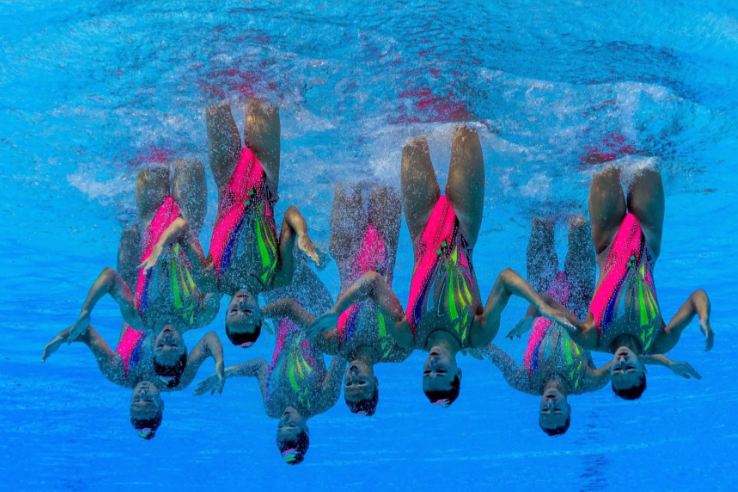
These more familiar synchronous swimmers and their Lilliputian ocean neighbors have a lot of water mixing power, especially when they number in the trillions.
The ocean pastures, just like pastures on land, must be cared for to remain healthy and abundant and it is the armies of Lilliputians that do the work. But in the living ocean as this new paper in Nature (and many more preceding it) describe, the tilling and tending of ocean pastures is performed by both animals and plants. And even more importantly they don’t blindly do this vital work on behalf of their blue planet and ours in an aimless unintelligent fashion, they do the work in the right way, at the right time, in the right place!
Every move they make, every breath you take. We need a hit song that mourns their loss.
Humanity has changed everything for the plankton through our nearly instantaneous, aka 100 year, emission of a trillion tonnes of CO2 from our fossil-fueled industrial age. Those trillion tonnes of CO2 already emitted, yesterday’s CO2, is already a near-lethal dose for ocean pastures and the life within them that stirs our blue planet’s living broth. The ocean pastures make 9 out of every 10 breaths of oxygen you breathe in in every breath you take.
More grass growing means less dust blowing.
Our high CO2 is helping plants on land grow better, which is called ‘global greening‘, and while more grass growing on land may sound good it means less dust blowing which is the unintended consequence of our fossil fuel addiction. On land plant life lives in mineral soil and it survives and thrives when the rains fall from the sky above. In the ocean plant life lives in water and it survives and thrives only when the vital dust falls from the sky above.
As the first lethal dose of our CO2 is already set upon the world the ocean pastures and their Lilliputian plants and animals are the first to begin dying. Ocean life is perishing at a rate unparalleled to anything taking place on land.
Take for example the well-known crisis of the plight of the Amazon Rainforest which today has been diminished by about 20%, this degradation is widely proclaimed as one of the most iconic environmental disasters on Earth. But in the blue part of this planet, the oceans that cover 72% of our world, an equivalent to one entire Amazon Rainforest of ocean pasture life has been eradicated every five years since 1950! That’s 12 entire Amazon forests, not merely 20% of one single Amazon gone! All for the lack of a little dust in the wind.
Have Hope Not Despair
So as to not leave you in a dark doomsday state of mind here’s the good news. The global climate change models that treat the ocean cooling as a simple passive lump of cold lead to a far more dire prospect for this blue planet than they ought to. We are indeed going to a global warming hell in a hand basket but the inevitability of it is not at all as dire as the world is being told/sold.
Most people feel oppressed by the doomsday scenarios that accompany almost every climate change discussion. If we can do anything seems doubtful, even if we spend trillions. Restoring the oceans cooling pastures to health, on the other hand, will cost mere millions and it will reward the world with billions of additional healthy nutritional fish to feed the multitudes as a ‘second miracle of the fishes.’
With revisions to climate models that assign the power of the living ocean even a fraction of its active solar-powered cooling capacity, the specter of global warming becomes neither so dire nor so imminent. Or at least that will be true as we restore the ocean pastures to the condition of health and abundance that they and we enjoyed less than 100 years ago. We can readily do this at a fraction of the cost of the trillions being dedicated to climate change.
You may read everywhere on this blog just how safe, sustainable, fast, and low cost restoring the ocean pastures will be. Join me.









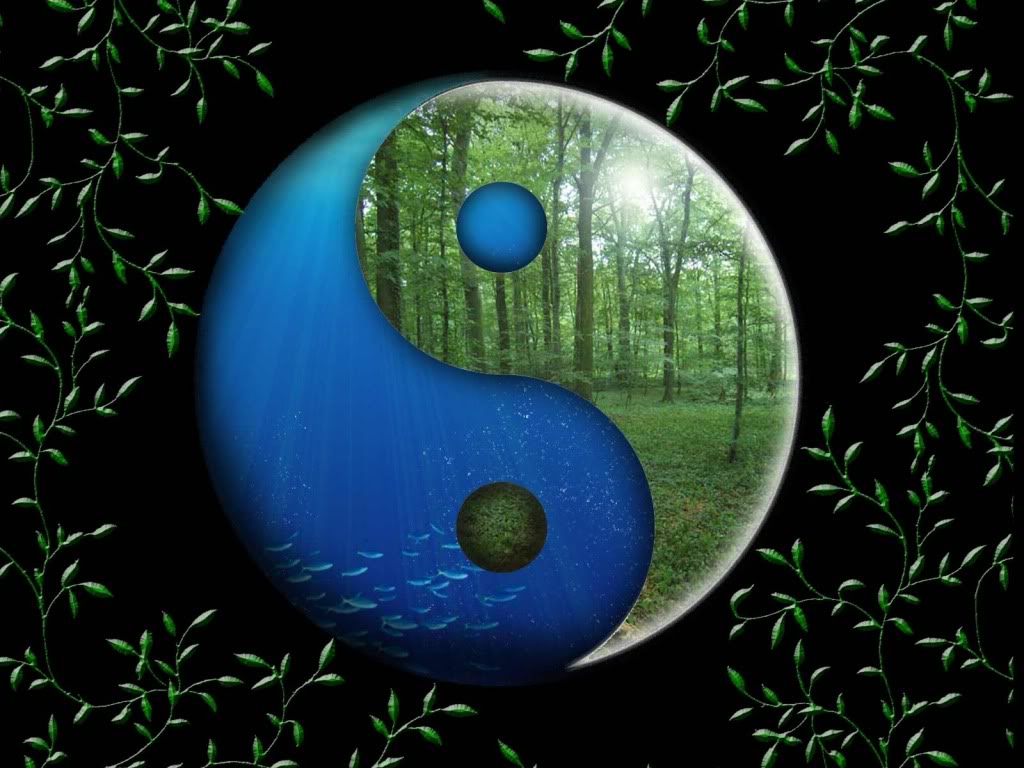
I have received some great comments and advice as a result of this post. Like all living documents on the internet, this one improves with age as help is provided to fine-tune its content.
The information contained in this blog over the past year must be put into action now!